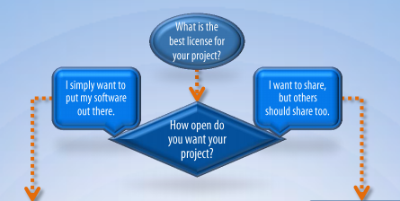Decisions, decisions. How do you choose an open source license?

<decisions>If you're a developer and you want to offer your products to the public, you need to protect it and yourself with a license. So-called open source licenses are a popular way to do just that. But, with more than 60 such licenses available to you, how do you choose the right one? It's difficult, but Protecode's open source licensing roadmap infographic can help. Developers will understand its top-down, decision tree style at a glance.
When licensing an open source project, all future iterations of that project can be credited to the developer for the foundation that was created, based on the license which was assigned to his or her work. There are a variety of different licenses available for developers to choose from depending on their open source software project. This infographic takes a look at four of these and will help the reader choose which open source license is the best fit for their project.

You first need to make the choice of how "open" you want your project. You can choose to just get your software out there in front of users or you can be a bit more conservative with a share type license.
Your choices are a "permissive" type license or a Copyleft license model.
At this point in the process, you have to choose a more specific path for your project. The choices seem fairly straightforward, but how can you be sure that the choice you make is going to be right for you in the longer term?
You have to choose how others will use your code and possibly your patents, if any, for permissive licensing. Or you need to decide how commercial vendors might use your code—either by including it in closed source, proprietary applications or by forcing the vendor to also use an open source option.
Now you've narrowed it down to specific license families. Your permissive license options are Apache 2.0 or MIT and your Copyleft license choices are LGPLv3 or GPLv3. Each license type has its own quirks and caveats, but where do you go from here? The choices from this point aren't exactly clear for some projects. That is unless you're an open source license expert.
You're at the point where you need to read the fine print of what each license allows and what each license protects.
Protecode's infographic can help you get started on your way to licensing your product or your project. The decision, ultimately, is yours to make.
About Protecode
Read this
Protecode Incorporated is a software company specializing in open source licensing and vulnerability management solutions, based in Ottawa, Canada. Established in 2007, Protecode offers its products and services throughout the world through a network of partners in the Americas, Europe, the Middle-East and Asia.
Protecode solutions help with managed adoption of open source software, accelerating development, reducing development costs, improving software quality, identifying security vulnerabilities, and removing Intellectual Property uncertainties.
To any organization that creates or consumes software, Protecode provides software analysis and code attributes management products and software audit services. Protecode's products can detect and manage open source and other third party content in a software portfolio at any stage of the software development life cycle.
</decisions>
Related Stories: